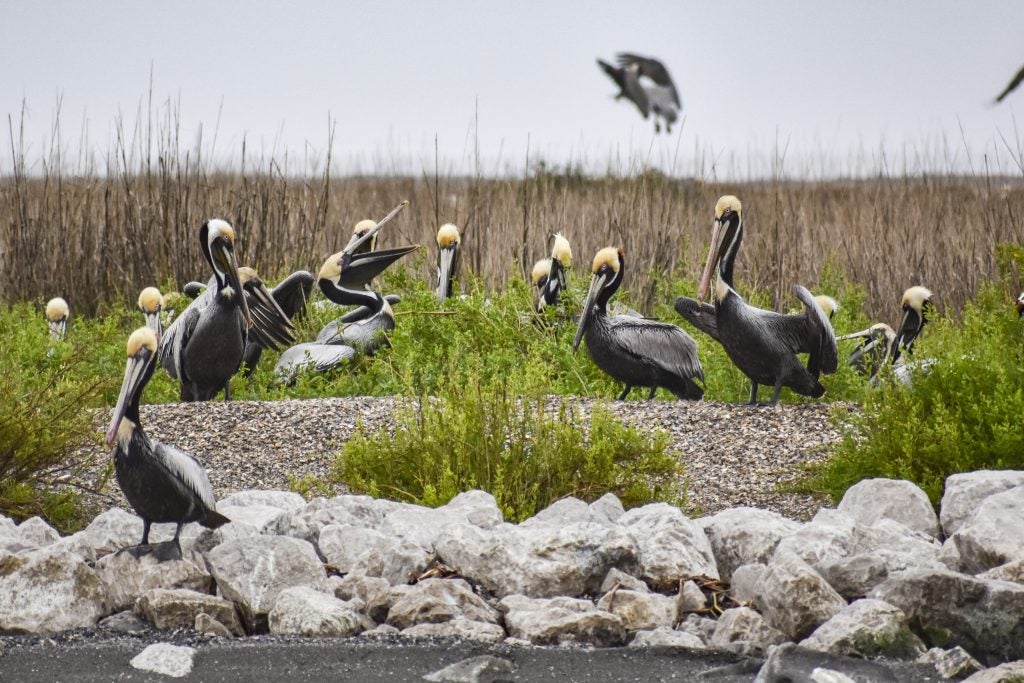With spring underway, thousands of brown pelicans are returning to nest on Queen Bess Island — a bird rookery island south of New Orleans in Louisiana’s Barataria Bay. What may seem like an ordinary annual event is actually quite remarkable, and a promising sign of recovery and resilience for Louisiana’s state bird.

Brown pelicans have returned to nest on Queen Bess Island following a massive restoration project. Photo credit: Halle Parker, National Audubon Society.
Until recently, Queen Bess Island was at risk of disappearing entirely from the forces of subsidence and erosion. Even worse, nearly ten years ago, the island was ground zero during the Gulf oil disaster, which occurred at the height of nesting season, killing or oiling thousands of pelicans on or near Queen Bess Island.
The oil spill took place only one year after the U.S. Fish and Wildlife Service removed the brown pelican from the federal endangered species list. Having recovered from previous threats, the population faced another major setback from the oil spill.
Today, brown pelicans are again nesting on Queen Bess Island and soaring across coastal Louisiana. Their return underscores the impact we can have by advancing meaningful conservation policies and working to restore and protect our coastal ecosystems.
As more areas are threatened by land loss and sea level rise, there is increasing urgency to learn from past success.
The revival of Queen Bess Island is a model for restoration
In February, Louisiana Governor John Bel Edwards officially reopened Queen Bess Island after the state’s Coastal Protection and Restoration Authority completed a massive, $18.7 million restoration using settlement funds through the Natural Resource Damage Assessment process.
The state selected Pontchartrain Partners, LLC to complete the restoration, increasing nesting habitat on the island from five to 36 acres. The contractors first strengthened the island’s shoreline with rocks and then pumped sand barged from the Mississippi River onto the island to restore its footprint. In some locations, contractors increased the elevation to four feet to allow for a range of habitat.

Before and after of restoration work on Queen Bess island. Photo credit: CPRA.
Going forward, the state plans to plant black mangroves and other vegetation to further enhance habitat and protect the island.
The restoration of Queen Bess is critical to long-term survival of brown pelicans in Louisiana, because, as incredible as it seems, this island alone supports 15% to 20% of total nesting activity in the state. In addition to brown pelicans, Queen Bess also supports a number of species, including roseate spoonbills, tri-colored herons, great egrets and royal terns.
But the revival of Queen Bess is only the latest in a series of conservation successes that have brought the brown pelican back from the brink.
How Louisiana’s state bird made a comeback
Fifty years ago, Louisiana almost lost its state bird entirely, as brown pelicans essentially disappeared due to widespread use of the pesticide DDT. This harmful chemical made pelican, bald eagle and other bird eggs too thin for birds to survive and decimated a number of populations.
Fortunately, in 1972, EDF lawyers and scientists played a major role in securing a nationwide ban on DDT. This ban, coupled with protections under the Endangered Species Act and a successful reintroduction program led by Louisiana’s Department of Wildlife and Fisheries (LDWF), not only brought the species back from the brink, but contributed to the record numbers of pelicans now soaring across Louisiana’s coast.
Specifically, after the birds had disappeared in the 1960’s, LDWF used Queen Bess Island, Isle Aux Pitre and North Island as nesting sites to reintroduce brown pelicans into Louisiana in 1968. By 1971, the state had documented 11 brown pelican nests on Queen Bess Island, which remained the only site of nests documented in Louisiana until 1979. By 1990, total nests on Queen Bess had increased to 400.
We must act with urgency to emulate these successes
Habitat for birds and other wildlife continues to be threatened by Louisiana’s land loss crisis, which claims a football field every 100 minutes. For example, another vital pelican rookery island, Cat Island in Plaquemines Parish, has completely disappeared from the map as a result of land loss, hurricanes and damages from the oil spill.
As we approach the 10th anniversary of the BP oil spill on April 20, 2020, it’s important to take a step back and reflect on progress and success stories like the brown pelican, with a recognition of the need to do more in the critical years ahead.
As more areas are threatened by land loss and sea level rise, Louisiana’s brown pelican reminds us of the opportunity we have to protect people and wildlife. But we must act with urgency. Share on X
EDF has worked with our Restore the Mississippi River Delta partners in the aftermath of Hurricanes Katrina and Rita and the oil spill to help the region’s ecosystems, communities and wildlife not just recover from disaster, but become more resilient in the face of climate change.
Together, we are working to advance a suite of priority coastal restoration projects that can help maintain a sustainable, diverse and bountiful delta for people and nature.









